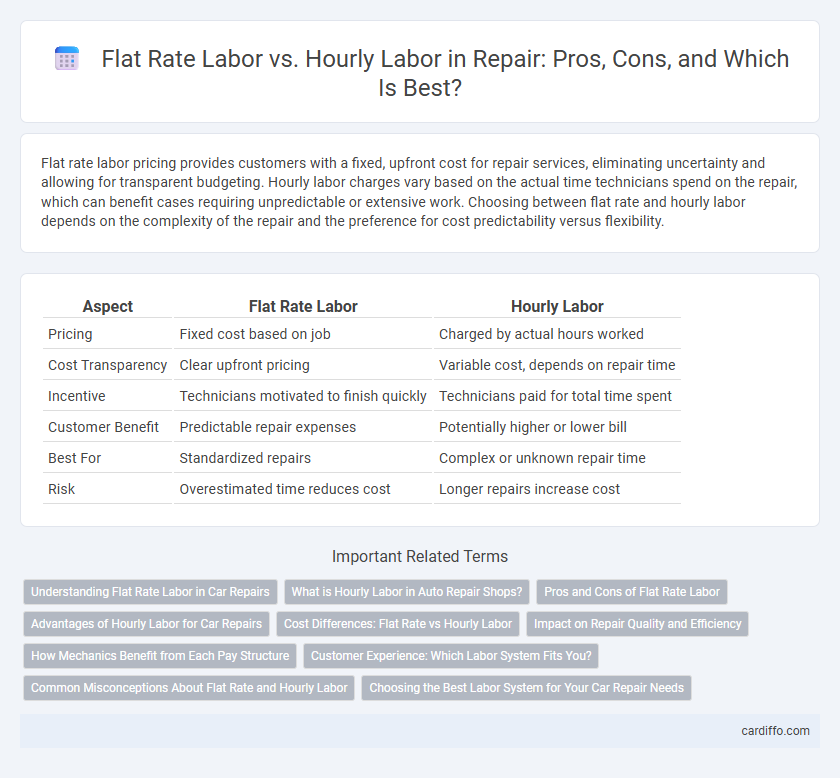Flat rate labor pricing provides customers with a fixed, upfront cost for repair services, eliminating uncertainty and allowing for transparent budgeting. Hourly labor charges vary based on the actual time technicians spend on the repair, which can benefit cases requiring unpredictable or extensive work. Choosing between flat rate and hourly labor depends on the complexity of the repair and the preference for cost predictability versus flexibility.
Table of Comparison
| Aspect | Flat Rate Labor | Hourly Labor |
|---|---|---|
| Pricing | Fixed cost based on job | Charged by actual hours worked |
| Cost Transparency | Clear upfront pricing | Variable cost, depends on repair time |
| Incentive | Technicians motivated to finish quickly | Technicians paid for total time spent |
| Customer Benefit | Predictable repair expenses | Potentially higher or lower bill |
| Best For | Standardized repairs | Complex or unknown repair time |
| Risk | Overestimated time reduces cost | Longer repairs increase cost |
Understanding Flat Rate Labor in Car Repairs
Flat rate labor in car repairs charges a fixed price based on the estimated time to complete a specific job, regardless of actual hours worked. This pricing method provides transparency and predictability for customers, as the cost remains consistent even if repairs take longer than expected. Mechanics use standardized labor times from industry guides like the Chilton or Mitchell manuals to determine accurate flat rates for various repairs.
What is Hourly Labor in Auto Repair Shops?
Hourly labor in auto repair shops refers to charging customers based on the exact time technicians spend diagnosing and fixing vehicle issues, with rates typically ranging from $70 to $150 per hour depending on shop location and expertise. This pricing model allows for precise billing but may lead to higher overall costs if repairs take longer than initially estimated. Hourly labor is preferred when repairs are unpredictable or require extensive diagnostics, ensuring transparency and fair compensation for the mechanic's time and skill.
Pros and Cons of Flat Rate Labor
Flat rate labor provides clear pricing certainty for customers by charging a fixed amount for repair jobs regardless of time spent, which simplifies billing and reduces disputes. This method can incentivize technicians to work efficiently but may lead to rushed work or overlooked problems if not carefully managed. However, flat rate can disadvantage customers when complex repairs take longer than expected, potentially resulting in less detailed service compared to hourly labor.
Advantages of Hourly Labor for Car Repairs
Hourly labor for car repairs offers transparency, allowing customers to pay specifically for the actual time technicians spend on diagnostics and fixes. This method aligns costs closely with the complexity of the work performed, preventing overcharges for simpler tasks. Mechanics benefit from accuracy in billing when unforeseeable complications arise, promoting fair compensation for their expertise and time.
Cost Differences: Flat Rate vs Hourly Labor
Flat rate labor charges a fixed price for repair services based on the job's scope, providing cost predictability regardless of time spent. Hourly labor billing fluctuates with actual repair duration, potentially increasing overall costs if complications arise. Customers often prefer flat rate pricing for budgeting certainty, while hourly rates may benefit smaller, simple repairs with minimal time investment.
Impact on Repair Quality and Efficiency
Flat rate labor incentivizes technicians to complete repairs efficiently while maintaining high-quality standards, as payment is consistent regardless of time spent. Hourly labor may lead to varied repair quality and longer job completion times due to the direct correlation between time and earnings. Repair shops using flat rate pricing often experience improved workflow efficiency and customer satisfaction through predictable costs and streamlined operations.
How Mechanics Benefit from Each Pay Structure
Mechanics benefit from flat rate labor pay by receiving a fixed amount per job, which incentivizes efficiency and skill, enabling faster repairs to increase overall earnings. Hourly labor pay provides consistent income regardless of job speed, offering financial stability during complex or unpredictable repairs that require more time. Each pay structure supports different work styles: flat rate benefits highly skilled, fast mechanics, while hourly pay assures steady wages for those prioritizing thoroughness and reliability.
Customer Experience: Which Labor System Fits You?
Flat rate labor provides customers with upfront pricing, eliminating surprises and enhancing trust during repair services. Hourly labor offers flexibility for complex repairs but may lead to unpredictable costs, potentially impacting customer satisfaction. Choosing the optimal labor system depends on preference for price transparency versus adaptability in service duration.
Common Misconceptions About Flat Rate and Hourly Labor
Flat rate labor is often misunderstood as overcharging, but it actually provides transparent pricing based on the job rather than time, ensuring customers pay for results instead of hours. Hourly labor can lead to unpredictable costs and longer repair times since technicians may charge for extended periods irrespective of work quality. Both methods have pros and cons, but flat rate pricing often enhances customer trust by setting clear expectations upfront.
Choosing the Best Labor System for Your Car Repair Needs
Flat rate labor provides a fixed price for specific repair jobs, allowing car owners to know the total cost upfront and avoid unexpected charges, making it ideal for straightforward repairs like brake replacement or oil changes. Hourly labor charges based on the actual time technicians spend on repairs, offering more flexibility for complex diagnostics or unforeseen issues that may extend repair time. Selecting the best labor system depends on the nature of the repair, with flat rate labor suited for routine services and hourly labor preferred for detailed inspections and customized repairs.
Flat rate labor vs Hourly labor Infographic

 cardiffo.com
cardiffo.com